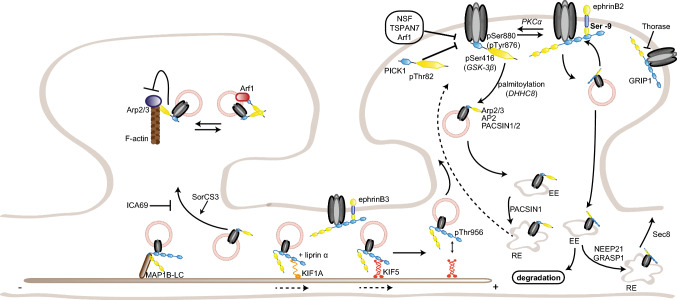Fig. 1.
Regulation of AMPAR trafficking by GRIP1 and PICK1. The PDZ domain-containing GRIP1 and PICK1 regulate surface AMPAR in opposite directions: GRIP1 primarily promotes AMPAR surface insertion, stabilization, and reinsertion after internalization, while PICK1 acts on internalization and intracellular anchorage. Their interaction with GluA2 subunits is regulated by GluA2 phosphorylation on the serine 880, which favors GluA2–PICK1 binding over GluA2–GRIP1. GRIP1 interaction with ephrinB ligands stabilizes surface AMPARs, at spine (ephrinB2, via the phosphorylation of ephrinB2 serine-9) or shaft (ephrinB3) synapses. Following internalization, PICK1–GluA2 also inhibits actin polymerization. PICK1 regulates AMPAR sorting, while GRIP1 also transports AMPARs to the synapse by interacting with the motor proteins KIF1A and KIF5; cargo release from KIF5 and the microtubules requires phosphorylation of GRIP1–Thr956 residue. Conversely, GRIP1 interaction with MAP1B-LC leads to AMPAR–GRIP1 trapping on the microtubules. EE early endosome, RE recycling endosome. Note for all figures: posttranslational modifications (with the causative enzymes, when known) and direct partners of AMPAR interactants relevant for their regulation of AMPAR trafficking are also included. No stoichiometry is implicated; binding sites are indicative only, and size ratios are not to scale

